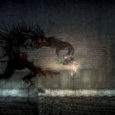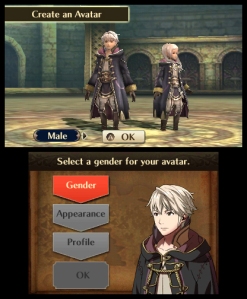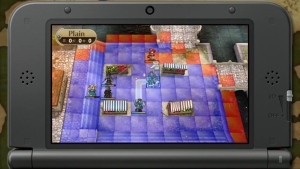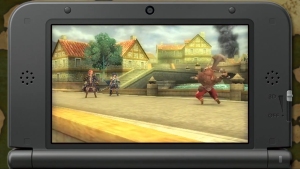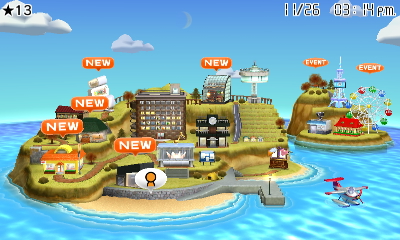
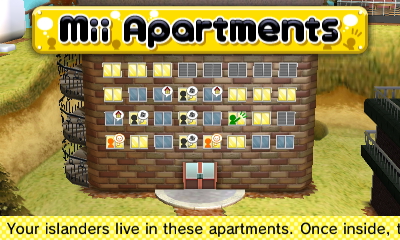
I’m what most people would consider a “filthy casual” when it comes to games, and I’m totally cool with that. My favorite games can be dropped and picked back up with ease, have a short story line (or none at all), and are simple to learn. Mario Kart, Super Smash Bros., Left 4 Dead, Nintendogs… the kinds of games I like to play are cemented in the “casual gamer” camp.
When Nintendo’s Tomodachi Life for the 3DS was released, I heard reviews that it was like a weirder version of Animal Crossing, and I was immediately intrigued. To me, it’s more like The Sims meets Animal Crossing — with a lot of Nintendo wackiness thrown in.
To call it a game is a stretch — it’s more like a visual novel in choose-your-own adventure format, with a few mini-games and customization options thrown in. Even after playing Tomodachi Life daily for several months, it’s still hard for me to categorize. Let’s delve into the weirdness.
Quirky, Open-Ended Gameplay
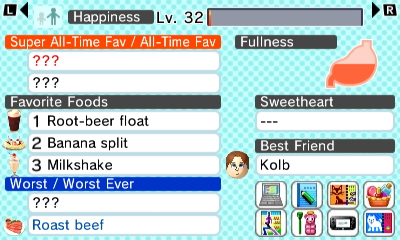
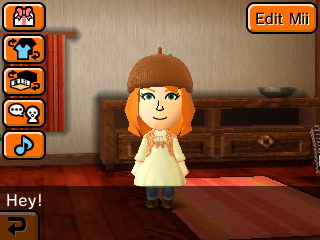
The quirkiness starts right away — the islanders refer to you as [your Mii’s name]’s look-alike. So you’re sort of the deity of the island as well as a friend to the islanders, and you interact with them directly by feeding, clothing, and playing games with your islanders. Are you a God? Can your islanders feed themselves or do they rely on you for everything? We just don’t know.
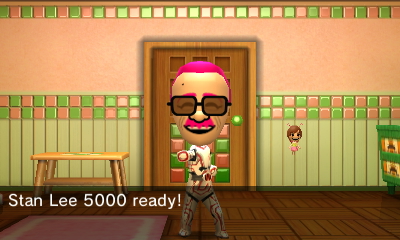
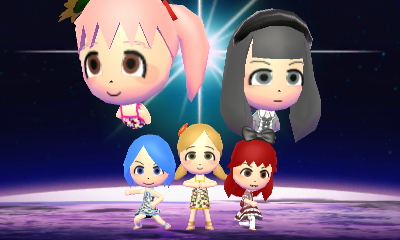 Wacky dreams and ridiculous photo studio set ups.
Wacky dreams and ridiculous photo studio set ups.Because all the characters are Miis, you can import Miis that others have created or make anyone you want to be an islander. My island is populated with characters from Madoka Magica, Adventure Time, and Rupaul’s Drag Race, among others. While there are limited personality types for Miis, they are pretty spot-on, and some of the stuff your favorite characters do and say is hilarious. You can also give each Mii a unique voice and items to give them a little more personality.
The main gameplay in Tomodachi Life comes from either solving islander problems, playing mini games, or unlocking events. Islander problems are anything from “I’m hungry!” to “Do you think so-and-so wants to be my sweetheart?” Mini games in Tomodachi Life are simple, but enjoyable: matching games, questions about your islanders, and simple item quizzes. Events happen whenever your islanders reach a new life stage, like marriage or having a baby.
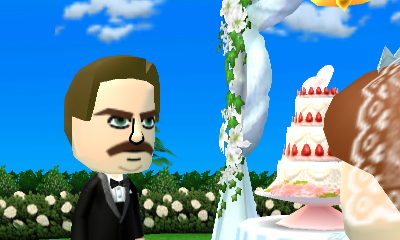
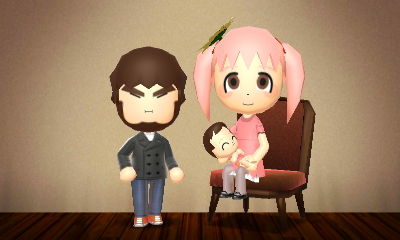 Ron Swanson marries Cooking Mama, and JonTron and Madoka had a baby!
Ron Swanson marries Cooking Mama, and JonTron and Madoka had a baby!
Aside from that, there are lots of other ways to stay amused: collecting all the items in-game, which rotate daily and seasonally; watching Mii news; discovering your islanders’ favorite and least favorite foods; watching your Miis give a concert; sending travelers to other Tomodachi Life games; taking photographs of your Miis; or simply observing your islanders’ shenanigans. It sounds simple, but there’s so much to do and each gamer could have a totally different experience with their island.
Wackiness Ensues
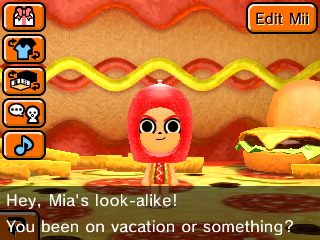 A little nosy, but not rude!
A little nosy, but not rude!
My favorite part about Tomodachi Life is that you aren’t penalized for playing sporadically or in short bursts. If you take a break from Animal Crossing, suddenly your town is covered in weeds and your villagers are furious with you. In other games, it’s hard to remember what you were doing and how to progress. In Tomodachi Life, though, your islanders are totally cool with you leaving for a few days… or weeks… or months. Then, once you do have time to play, you can play as much or as little as you want. Only have 10 minutes? Cool! Feed your islanders, fix a few problems, then log off for the night. As far as games go, it couldn’t be more forgiving if you are an extremely casual gamer.
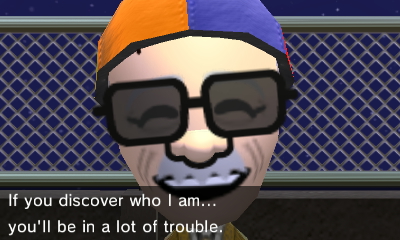
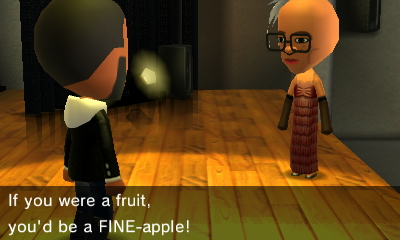 Some of my favorite moments so far: Threatening Stan Lee, flirty RuPaul with a crush on Kanye.
Some of my favorite moments so far: Threatening Stan Lee, flirty RuPaul with a crush on Kanye.
The downside for people like myself who enjoy games like The Sims is that you can’t really control the “story” of Tomodachi Life. For example, if someone has a crush on someone else, you can tell them it’s a terrible idea to pursue it, but you can’t manipulate the game much further than that. I’ve been trying to get my Mii to date my IRL-partner’s Mii for months, and they are still just best friends. For the control freaks among us, this game might not be what you are looking for. But if you’re a little more chill about the fate of your islanders, then it’s plenty of fun.
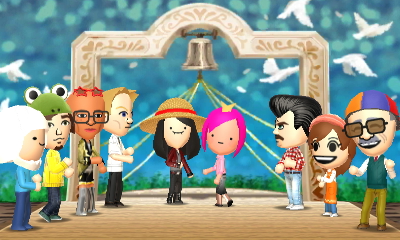
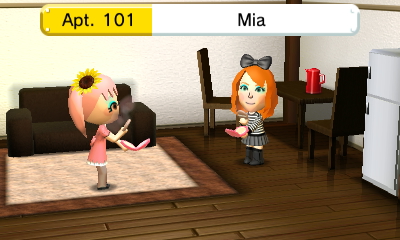 Marceline and PB marry (in my dreams), and Madoka and I have a makeup party.
Marceline and PB marry (in my dreams), and Madoka and I have a makeup party.
Another weird thing is that Tomodachi Life doesn’t allow for same-sex relationships. Nintendo has announced that this will be rectified in a sequel, but there’s an okay work-around currently. A Mii can have any appearance and clothing, regardless of intended gender, so if you have an OTP you really want to recreate in Tomodachi Life, just make one of them the opposite gender. I hope in future games, there’s an option to have attraction to men, women, both, or neither, or maybe even some other gender identities, but I’m not too hopeful that it will go beyond gay and straight.
Perfect for the Casual Gamer in Your Life
Despite the relatively simple gameplay, Tomodachi Life has me hooked. From watching someone skyrocket to the moon when eating their all-time favorite food (an apple?!) to discovering that three different islanders have a crush on your least-favorite Mii, watching your Miis interact is highly amusing. If you like open-ended games like The Sims and Animal Crossing and adore weirdness, or you are looking for a game you can play in short bursts, then Tomodachi Life is the perfect game for you.
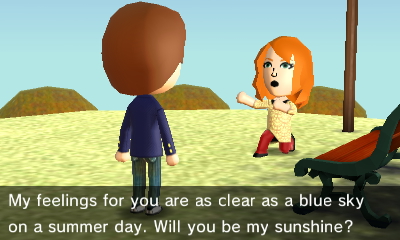
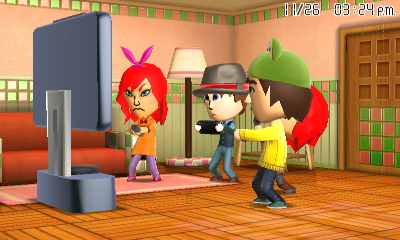 Love confessions and Wii U gaming.
Love confessions and Wii U gaming.
More Tomodachi Life Resources:
- Vinnie from Vinesauce streams Tomodachi Life regularly, and the results are hilarious.
- Tomodachi Life QR Codes is a great source to share or import Miis.
- My personal Mii QR code, in case you want me in your game!
 |
| Having Friends visit can be great, unless they are jerks and mess everything up |
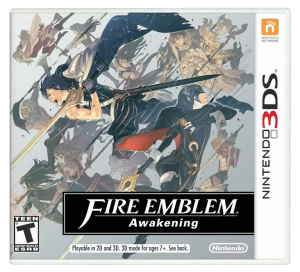
Fire Emblem is a franchise with a rather complicated past, and one that fans in North America and Europe have struggled with. The first six games of the series were never released outside of Japan, and although the next four installments were released internationally, they catered to a very specific niche audience. To many gamers, the name “Fire Emblem” merely prompted a discussion of Marth, Roy, and Ike in Super Smash Brothers. To die hard fans like myself, the name meant a game with a deep, sweeping storyline, engaging turn-based tactics, and the certainty of a good challenge. After years of waiting, Intelligent Systems has not only released a game which caters to the die-hard Fire Emblem fan, but also to gamers who have never touched a strategy RPG.
Without spoiling anything, you soon find your customized Avatar unconscious in the middle of a field, with no memory of anything but your name. However, you are rescued by Prince Chrom of the Halidom of Ylisse, and his band of Shepherds. After helping Chrom protect a small town from a group of bandits, you are adopted into the Shepherds as their tactician. You will find yourself constantly faced by new enemies while rallying new allies to your cause. It is nothing short of an awesome adventure.
Awakening’s combat system is relatively intuitive and easy to grasp, especially to gamers who have picked up games like Advance Wars or Final Fantasy Tactics. Each battle takes place on a grid system, which your units move along like pieces on a game board. After all of your units have taken an action, the enemy’s turn begins, and so on. It’s a combat system with a surprising amount of depth, and you will have to think carefully about how you position your units, what weapons they equip, and what actions the enemy AI might take. There will be times when you have to weigh the risk between using a character’s turn to heal, or to risk death and attack a weakened, but dangerous, enemy in order to finish the chapter. Some battles may challenge you, but the feeling of success you experience as you watch your characters grow is unparalleled.
In the majority of past Fire Emblem games, characters could use a Master Seal to “class up” once they reached a certain level. For example, an Archer would be able to class up into the more powerful Sniper, a Pegasus Knight into a Falcon Knight, a Myrmidon into a Swordmaster, and so on. However, Awakening borrows two class up mechanics from previous Fire Emblem titles: branching classes and reclassing. Now, when a character classes up, you will have two class options to choose from (i.e. A Myrmidon can either become a Swordmaster or an Assassin). Or, you can use a “Change Seal” to become a completely different unit while retaining learned skills. This system has a complexity that allows you to customize each unit to meet your army’s needs!
Perhaps the most interesting new development that Awakening brings to Fire Emblem gameplay is the Dual System. In previous installments, characters would fight opponents one on one. In Awakening, if two characters are placed adjacent to each other, they will join each other in combat and boost each other’s stats. If those two characters have a support relationship, the status boosts are increased! You can also use the Pair Up command to join units together in combat for great status boosts (at the cost of the support character losing the ability to move freely and gaining less experience). It’s an amazing tactic, as you can pair a fragile Mage with a sturdy Knight and receive a substantial boost to the Mage’s defense stat!
One of the greatest things about Awakening is the amount of gameplay customization that is available. You can choose the difficulty level at the start of each new safe file, with the option of playing on Normal, Hard, or Lunatic. (Beating the game on Lunatic unlocks Lunatic+, which is basically designed to test every aspect of your sanity). You can also choose between playing the game on Classic or Casual mode. One of the trademarks of the Fire Emblem franchise is that when a unit falls in combat, he/she dies and is gone from your army forever. The exceptions are the main character or “Lord” of the game (in this case Chrom and your Avatar), whose deaths will result in a game over. Classic mode retains this battle mechanic, while Casual mode allows fallen units to return in the next chapter. However, Chrom or the Avatar’s death will still result in a Game Over.
While there are definitely benefits for new players opting to play on Casual mode, that sense of risk definitely takes something away from the Fire Emblem experience. At one point in an early chapter, I moved one of my units (a powerful but frail Mage) one square more than I had originally planned. Not only did I place her out of range of her support partner, but I had also placed her in range of three enemy Cavaliers. There was no way to correct my oversight, and so I could only watch in terror during the enemy phase, as they rode down on my fragile and friendless Mage. The first attack took away more than half of her health, and she responded by killing the enemy. The second would have killed her, but her Miracle skill activated, and saved her with only one health point remaining. My heart stopped in my chest as the last cavalier readied his lance for the fatal charge…and miraculously, my mage dodged the attack and struck down the opponent. At the start of my next turn, I felt only relief as I healed my Mage and continued my offensive. If her support partner was adjacent to her, she could likely have dodged every attack with ease. If I had not moved her that extra space, she would not have been in any danger at all. In Awakening, one single action can turn the tide of battle, or cost a loved character his/her life. It’s a feeling only Fire Emblem can produce, and Casual mode mitigates it somewhat.
Fire Emblem: Awakening is likely the series’ most well presented title, if it doesn’t possess the highest production value of any game in the 3DS’s library. The animated cutscenes are beautifully rendered and fully voice-acted, and characters also have brief soundbites throughout the text-box dialogue, as well as during battle. Every member of the large cast feels unique and memorable, and you will want nothing more than to watch their stories develop through the support system. Supporting characters can also eventually marry, and possibly result in a child you can later recruit to your army!
The story is also perhaps one of the most engrossing I have experienced in a strategy RPG. What starts off as a simply fighting off a small pack of bandits turns into a story where entire nations are fighting for survival, with Chrom’s gang caught in the middle and struggling to save their world. There are moments of pure laughter, triumph, heartache, and loss. The soundtrack is one of the highest quality, as each track captures the emotion of the scene perfectly. Even early in the game, one tragic moment, highlighted by the lamenting soundtrack, had me in tears.
This is a game whose depth can keep you going almost indefinitely. If you wish to play with the various class-up mechanics and create the strongest possible army, you can expect to put a minimum of 60 hours into this game. For those of gamers who wish to simply experience the story without micromanaging the strategic depth, you can experience it all on a lower difficulty in 30-40 hours without being punished for it. There are plenty of optional sidequests with new characters, as well as paid DLC chapters and free Spotpass teams all featuring former Fire Emblem characters to recruit. With the complexity of the support system and all of the online add-ons being released every week for the next few months, this game has insane replayability. I haven’t even fully completed my first play through, and I’m already anxious to start my second.
Verdict: This game is one of the greatest additions to the 3DS library, and one of the best strategy RPGs ever made. Fans of the Fire Emblem franchise absolutely must get this game, as it not only gets everything right, but it also contains wonderful references to previous titled peppered throughout support conversations and storyline, as well as the DLC chapters. Newcomers to Fire Emblem will still find Awakening to be a fantastic introduction to the series, and a great addition to their gaming library.
Long story short, if you have a 3DS, get this game. You absolutely will not regret it.
Kingdom Hearts was a radical idea when it was first introduced—nobody had ever thought to pair Disney worlds with Square Enix characters in a platformer setting. Since then, it’s become a staple for Disney games, and one of the most well-known Square Enix series. For full disclosure, I love Kingdom Hearts. I’ve played every game since the inception of the series and I consider it to be one of my top five favorite franchises. That being said, I can recognize when the games are lackluster, and I’m more than willing to point those out. Yes, every Kingdom Hearts game on a Nintendo console has been a snore fest with less-than-stellar controls, odd battle mechanics, or a convoluted story. After three titles from GBA to DS, Kingdom Hearts makes the jump to Nintendo’s latest platform with Kingdom Hearts: Dream Drop Distance (3D). Has the new console inspired higher game quality, or is this yet another title most fans of the series would tell their friends to pass on?
A hallmark of the Kingdom Hearts series is its unlikely mashup of Disney and Square-Enix. Though much of that is preserved in this game, they seem to have dropped the ball more than usual. There are exactly 5 Square-Enix characters present, all of them in Traverse Town, and all of them from The World Ends With You. Though I’m elated that there are new Square-Enix characters, I’m disappointed that there are so few— I actually enjoy seeing those characters more than the Disney characters. They make up for it in the fact that almost all of the worlds are new, from the Hunchback of Notre-Dame to the Three Musketeers to Fantasia. New Disney worlds are just pouring out of this game, though that is made slightly bittersweet by the fact that Donald and Goofy are not by your side, the developers choosing instead to allow you to have nice versions of the Dream Eaters. I will admit that the new sidekicks are cuter though.
The story of Kingdom Hearts, throughout the series, has grown from playful and interesting into a monstrously complex tale. First there were Heartless, then the Nobodies were added and that was fine, but there were also special Nobodies (which was okay too) then bugs in the datascape (well I guess that’s what would be there, yeah) and Unversed (wait what?), and now a new breed of enemy are introduced called Dream Eaters (that’s it, I need a spiral notebook). When there was just one keyblade wielder, now there are multiple, so many that they actually had a gigantic war some time ago and there’s one evil guy who must share a mother with Ganon because he can’t die. Not to mention people trapped inside one another’s hearts and sleeping worlds, but others were locked away while some were transformed and who even knows what the special Nobodies are all about and sigh…
You get my point. This story is Complicated, proper title. Dream Drop Distance only exacerbates the problem by adding in a new realm of worlds, a new type of monsters, and a few retcons to the story. Sure, they give you summaries of each game, but that’s like reading the Spark Notes of the history of the entire world and expecting to understand it. Hardcore fans of the series will find this title necessary, considering it’s rumored to be the last game before Kingdom Hearts III, and the ending says as much as well. If you have decided to hop into the Kingdom Hearts series, or have missed out on some games, you’ll either need to read up on the internet, watch some cut scenes, or have a diehard fan explain it all to you because it’s absolutely 100% necessary to understand why you’re doing what you’re doing. If you care not about motivation, then you wasted your time by reading the previous two paragraphs and for that, I am sorry. This next one is for you though.
The combat in this game is remarkably fluid, thanks in no small part to the Flowmotion system. It’s difficult to describe it without a visual reference, so here is a demo of it:
http://www.youtube.com/watch?v=qLkX_QXNGxo
Now, with just the press of a button, you can kick off of buildings, grind rails and ropes, execute powerful combat moves, and reach unattainable areas. The system integrates seamlessly with combat and it soon becomes something you rely upon quite often as it’s generally faster and more powerful than your standard attacks. Whereas in previous KH games, you’d be spamming the attack button, hoping to win in the end, this will have you looking for terrain to jump off of, poles to swing on, and special moves to execute to kill your enemies faster. Not only does this system make combat more fun, but it also engages the player more. I know there were more than a few times in which I zoned out in KH fights until I had won, but with this game, I’m constantly strategizing and trying to find more powerful moves. The only bad thing about it is that it seems the game was designed before the system was implemented, because there are so many objects and items to help you jump higher or farther, but with Flowmotion, you can jump infinitely high as long as you have a wall, and there’s no gap in the game too big to air surf across.
In addition to the new Flowmotion system, Flick Rush is a new minigame added to KH which allows you to pit your spirits against others in an arena. This game essentially replaces the Olympus Coliseum from previous titles with a game that requires a bit more strategy. You send three spirits into the ring to do battle against three other spirits. Cards for each spirit are distributed and have either attacks or support magic on them along with a number. If the number of the combined cards you play on the field is greater than that of your opponent, you cancel out their attack and do your own. If they are equal, you duel against each other and try to match three slot machine-esque symbols. Though it’s certainly an add-on meant to extend gameplay, it is no less fun and entertaining. The battles are intense, the strategy is intriguing, and it’s every bit as satisfying to win as it was in Olympus.
The art in this game looks about as good as Kingdom Hearts: Birth by Sleep on the PSP, and sometimes surpasses it. Specifically, just the facial rendering of the characters from Tron: Legacy is surprisingly accurate especially considering that it’s a handheld console.
The 3D in the game is what you would expect from a 3DS title, namely that there are a few instances in which it’s really noticeable and cool, but most will prefer to have the 3D off. Even so, this looks to be one of the best looking games on 3DS to date, not only because of the hardware, but also because of the colorful backgrounds, and smooth animations.
A problem KH: 3D suffers from is the camera. Since there’s only one circle pad, it’s up to AI or shoulder buttons to control the camera, and it can be quite frustrating. I often found myself trying to turn the camera, only to end up in a worse spot than before, or get the camera to where I like it, only to have it snap back to the exact position I was just in. The quick solution for this is to get a circle pad pro, though that’s an extra $20 plus battery investment to solve a mildly annoying problem.
Verdict: The bottom line is that if you’re a KH fan, you’ll enjoy this game. It has its problems, but it’s still marginally better than the other Nintendo Kingdom Hearts titles and rivals Birth by Sleep in gameplay, even if the story is a convoluted mess. If you’re looking to jump in to the series, I wouldn’t recommend starting with this one, but if you can handle some confusion and accepting high level facts without need of explanations, you could do worse than Dream Drop Distance. Play this game (and the whole series while you’re at it) if you like platformer adventure games, intriguing and fun storylines, or just want to hang out in some Disney worlds without having to be in Florida.
For more AristoGamer reviews, check out our website at http://www.aristogamer.net


